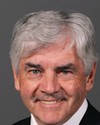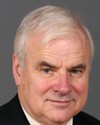moved that Bill C-37, An Act to amend the National Capital Act and other Acts, be read the second time and referred to a committee.
Mr. Speaker, since its creation in 1959 the National Capital Commission has ensured that the national capital region would remain a place of which all Canadians can be proud. Our government believes that this region is a second home for every Canadian.
In fact, the national capital region has a special place in our history and heritage. It is for that reason among others that we must take action to promote and protect it.
That is officially the mission of the National Capital Commission.
The decisions made by the commission are consistent with the role of the region, not only for those who have the privilege of living here, but also for all those who have the good fortune to call Canada their home.
The mandate of the commission is to plan and build a national capital that is beautiful and that reflects the unique character and significance of the seat of the Government of Canada.
Not only does the NCC develop, conserve and improve the national capital region, but it also organizes and sponsors a great number of events that enrich the cultural and social fabric of the region and of the country as a whole.
Before I outline our government's action plan for the National Capital Commission, I would like to take this opportunity to remind the House of the important role this city and surrounding area have played in Canada's development.
From the time when the Ottawa River was jam-packed with fallen white pines on their way to Quebec City and onward, to the vibrant G8 centre of today, Canada's capital has evolved with the nation.
From its humble beginnings as a rough-and-tumble shantytown far from major centres of Toronto and Montreal, today the capital region is a thriving metropolis straddling the border of Canada's two most populous provinces, Ontario and Quebec.
The desire to protect and maintain the beauty of this region is almost as old as Canada itself. In 1899 the Government of Canada established the Ottawa Improvement Commission in order to beautify the city, including its parks and lands along the Ottawa River.
A series of unfortunate incidents occurred in the early 20th century that had a noticeable impact on the region. Among the most damaging, the great fire of 1900 and another fire in 1916 which destroyed the Centre Block of the Parliament Buildings.
If not for the dedicated efforts of many people, the Centre Block may have never been rebuilt and our two cities would have evolved very differently. Instead, successive governments realized how important it was to build a strong capital region in the image of the country and for all Canadians.
By the start of the second world war, attractive parks and driveways and public buildings were seen around the capital. Initiatives were well underway to protect the forests in the Gatineau Park.
Ten years later, the government asked French architect Jacques Gréber to develop a strategic plan for the national capital region.
His vision, explained in a document known as the Gréber report or the Gréber plan, was presented to the House of Commons in 1951, before it would significantly shape changes in the capital region, during the second half of the last century.
Indeed, the National Capital Act came into effect in 1958. The national capital region was then officially defined as an area of approximately 4,700 square kilometres that included 27 municipalities, in two different provinces. The act also established the National Capital Commission as the federal body responsible for the capital region.
The commission is now responsible for a large number of properties and popular events in the region, to which both locals and visitors are deeply attached.
Indeed, many Canadians have had the opportunity to enjoy these activities, whether it is skating on the Rideau Canal during Winterlude, or admiring the fireworks from Parliament Hill. Thanks to the NCC, the national capital has all kinds of exciting attractions for Canadians.
However, the National Capital Commission is responsible for more than just annual celebrations. It also oversees the Greenbelt, the parkways, bike paths and the Gatineau Park.
This government recognizes the importance of the National Capital Commission in the region and the rest of the country. This is why we have sought to keep it relevant to the times.
In 2006 the Prime Minister named me minister responsible for the National Capital Commission. Shortly after I launched a review of the commission to assess the continuing relevance of its mandate, mission and activities.
An independent panel, chaired by Gilles Paquet, recognized that capital cities were distinct and most capitals had an agency responsible for their oversight. These agencies are charged with planning work, reviewing architecture and design, handling heritage buildings and managing public programming events.
During its review, the independent panel held meetings with numerous experts, received written briefs and heard oral presentations at public meetings in Ottawa and Gatineau from more than 100 people. The panel considered the opinions raised by all stakeholders, including concerns regarding the expansion of the National Capital Commission's mandate, governance mechanisms and lack of clarity in legislation.
In December 2006, the independent panel released its report to the public. The panel's report was comprised of 31 recommendations, including renewed funding, new rules for openness for board meetings, separation of the roles of the chief executive officer and board chair, a more direct connection to Parliament and a new focus on the environment.
Our government has implemented a number of measures to follow up on the panel's recommendations. For example, in the 2007 budget, we increased NCC funding to $15 million. This additional money has allowed the National Capital Commission to continue its important work, without having to give up on some assets, such as the Greenbelt.
We have also established the distinct positions of chairperson and chief executive officer. Then, in September of last year, the government authorized the National Capital Commission to acquire private properties located in Gatineau Park, without having to seek approval for every single transaction.
We have achieved a lot in terms of implementing the independent panel's recommendations.
The amendments being proposed in the bill take into account the majority of the panel's remaining recommendations, the intentions of private members' bills presented in Parliament and public comments. If passed, the amendments proposed by the government will make the NCC operations more transparent and accountable and will allow the NCC to better fulfill its mandate.
Among the major changes brought forward, let me review a few.
The first requires the board directors to hold at least four meetings in public per year, while still maintaining the option to have closed-door meetings, if necessary. This was an extremely important issue when I sat as a town councillor in Gatineau city hall. This was an important area because town councils in both cities were open to public discussion. It was, needless to say, an extremely important element.
The second requires the board of directors to submit once every 10 years a 50-year master plan to the National Capital Region to be tabled in the House of Commons. This is similar to what we see in many municipalities across the country, where the schema is tabled so that everybody can have a better view of where their community is going over the course of the next several years.
Through these changes, we are formally recognizing the fact that the NCC is already responsible for six official residences, and we are also recognizing the role that it is already playing in transport planning in the capital region.
The NCC will no longer have to seek cabinet approval for individual real estate transactions such as acquisitions, disposals and leasing. From now on, the way the NCC manages this type of transactions will be subject to approval under the current annual corporate planning process.
This legislation establishes the boundaries of Gatineau Park, and it emphasizes sound environmental stewardship.
Moreover, the regulatory powers of the National Capital Commission would be strengthened to better protect its lands and natural habitats.
As the legislation currently exists, there is no legal requirement to hold any meetings in public at all. Therefore, in 2007, following the mandate review of 2006, the commission took the initiative to become a more open and transparent organization. It invited the public to come to its board meetings. The first of these meetings took place in November 2007, and this was a good step toward modernizing the crown corporation.
The amendments proposed by our government will require that the commission's board of directors meet in public meetings at least four times a year. This will help make the more organization more transparent and accountable.
Currently the National Capital Commission does not have any requirements to publish any planning reports. However, by requiring the organization to submit a 50-year master plan at least every 10 years to the Governor-in-Council and table it in the House, the public will have a better sense of the overall direction and plan for our national capital region.
For many residents, the national capital region's Gatineau Park is an important green space and one of the most popular regional amenities throughout the year. Over the past few years, this government has heard from stakeholders, including members of Parliament, that the park is not being adequately protected.
The changes that we are making to the National Capital Act would require the commission to manage its properties in accordance with the principles of responsible environmental stewardship, with particular attention being given to maintain its ecological integrity. These changes would ensure that the Gatineau Park's breathtaking beauty and rich history would remain preserved for generations to come.
One key element in the mandate of the National Capital Commission is the National Interest Land Mass. These lands are located in the national capital region and have been acquired by the federal government over the past century. This land is considered essential to the functioning and experience of the capital, including the greenbelt, the Gatineau Park, riverbanks, public places and commemorations.
The existing National Capital Act is silent on the National Interest Land Mass. This has caused confusion among stakeholders, specifically regarding the types of properties to be included as part of this collection of lands and the process used to designate these properties.
The bill before the House proposes that the commission may designate or remove designations of properties that are part of the National Interest Land Mass only if pertinent regulations have been approved by the Governor-in-Council. These regulations would set out the criteria that are used in deciding which properties should be included and the process followed by the commission in arriving at these designations.
The National Capital Commission has a number of tools at its disposal to ensure that the lands for which it is responsible are properly administered in the interests of Canadians over the long term. Currently, the NCC's responsibilities are limited to protecting property, preserving order and preventing accidents.
The proposed legislation would allow the Governor in Council to make regulations governing the use of the property and the activities that take place there, and protecting the area's environment, the goal being to improve real property management and environmental stewardship. The National Capital Commission should have the means to enforce these regulations. Accordingly, the bill provides that any person who contravenes these regulations can be fined.
The proposed changes to the legislation also aim to make the commission, and specifically the deliberations of its board of directors, its long-term planning activities, and its decisions related to the national interest land mass, more transparent. In addition, the bill places a special emphasis on the protection of not only the real property for which the NCC is responsible, but also the environment and ecological integrity of Gatineau Park. As well, the bill recognizes the role the commission plays in areas such as transportation planning and the management of official residences in the national capital region.
I urge all members to vote in favour of this bill to keep our national capital region vibrant and a place of well-being for future generations.















